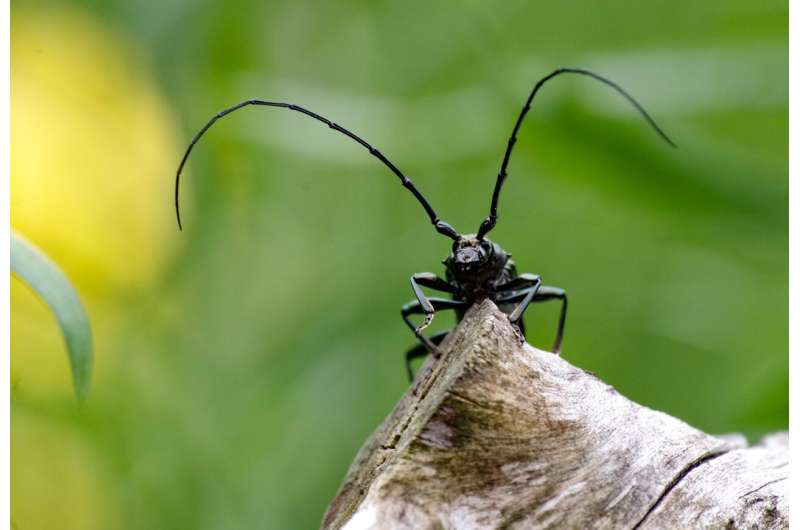This article has been reviewed according to Science X's editorial process and policies. Editors have highlighted the following attributes while ensuring the content's credibility:
fact-checked
trusted source
proofread
Longing to know about longhorn beetles in Australia

The Titan beetle (Titanus giganteus) is the biggest beetle in the world. It's a dark brown colored longhorn that lives in the Amazon and grows to 17.7 centimeters long.
The longhorn family (Cerambycidae) includes more than 33,000 species worldwide. Around 1,400 species are native to Australia.
You can learn about them all in the three-volume Australian Longhorn Beetles series.
The long and short of longhorn beetles
The long horns of Longhorns are their antennae. They use them to sense chemical cues, including alkaloids to help find a host plant or pheromones to help find a mate.
Dr. Adam Ślipiński, is a beetle researcher at our Australian National Insect Collection and the lead author of all three volumes on longhorns.
"Some longhorns, like the European house borer (Hylotrupes bajulus) or the Asian longhorn beetle (Anoplophora glabripennis) are quarantine pests. But most longhorns perform the useful roles in nature of pollinating native trees and recycling dead wood," Adam said.
"Telling similar species apart depends on looking at the sculpture and appendixes of the body. Their antennae are very diverse. Some species have spectacular horns longer than their bodies. Others have feathered horns or even short horns."
Like all beetles, longhorns have hard outer wings called elytra, which give beetles their characteristic shape. In some longhorns the elytra are fused, meaning they can't fly. Longhorns may be dull brown or feature colors or patterns. Some species mimic ants and wasps or other beetles that are unpalatable to predators.
Prioninae: a subfamily of giants
In the latest volume, Adam and his co-authors spent four years studying 5000 specimens of longhorns in the subfamily Prioninae.
The book covers 160 species living in the Australo-Pacific region, including 14 species that are new to science.
"Longhorns in this subfamily are heavily built and usually brown or black because they are nocturnal. The few species that are active during the day are colorful," Adam said.
"Most species are very localized, found only in one location. This puts them at risk when the environment changes because they are not very mobile and don't disperse far.
"Their larvae, or grubs, develop inside damaged or dead trees. They probably live for several years, feeding on the dead wood. In Australia and in many Pacific nations, larvae of longhorns are treated as delicacies, eaten raw or roasted.
"Adults don't live long, a few weeks or maybe only days in some cases. They need to find a partner, mate, find a host plant and lay eggs."
Adam said the adults probably don't eat, despite many species having large mandibles.
"These are necessary to emerge from the pupal chamber, which the larvae make inside the log they fed on," he said.
If you'd like to spot an adult, you'll need to wait for late spring and summer when the adults emerge. They are often attracted to light, like moths, so you can set up a white sheet with a light bulb. The book notes the best time to do this is a warm night, after rain, when the moon will rise very late in the evening or early in the morning, regardless of its phase.
"Some longhorn beetles may make a hissing sound, but I've never heard this and we're not sure how they would. They don't seem to have the structures other insects use to make sound, but maybe they use their elytra," Adam said.
Dr. Adam Ślipiński and Dr. Hermes E. Escalona completed the first and the second volume of Australian Longhorn Beetles in 2013 and 2017. The first volume won the Whitely Medal from the Royal Zoological Society of New South Wales. It also won the 5th J.O. Westwood Medal for Excellence in Taxonomy from the Royal Entomological Society and the Natural History Museum in London.
The third volume of series was co-authored by Roger de Keyzer, research associate from the Australian Museum, and Mengjie Jin, who completed her Ph.D. on phylogeny of Prioninae longhorns. It was published by the Australian Biological Resources Study and CSIRO Publishing.
Adam is now focused on completing volumes three and four of his other series, Australian Beetles, with his co-author John Lawrence who is turning 90 next year.
"Twenty-three years ago, I came to Australia from Poland. In Europe and North America, the beetle fauna was well known and there were many books for identifying beetles," Adam said.
"There was nothing like this in Australia where the beetle fauna is enormous and largely unknown. I wanted to change this, to provide people with a foot in the door to understand Australian beetles and to give back to my new country."
Provided by CSIRO




















